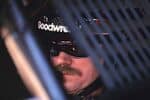I freely admit that when my career as a motorsports journalist began, I sought out a man named Travis Carter.
It seemed the natural thing to do. He was a lot like me. He was my age, relatively new to the sport of NASCAR stock car racing and, at 23 years of age, the crew chief for a championship team.
Unlike older and more seasoned crew chiefs, Carter seemed to be easily approachable – at least to me. He wasn’t like the often-irascible Harry Hyde, the well-experienced pit boss for Nord Krauskopf’s team, or the authoritative Dale Inman, who held the same job at Petty Enterprises and reportedly didn’t like the company of reporters.
Carter was raised on a tobacco farm near the hamlet of Ellerbe, N.C. He became a mechanic on the NASCAR team owned by L.G. DeWitt, a Richmond County resident who owned a trucking company and peach farms. He was also the head of North Carolina Motor Speedway in Rockingham.
Benny Parsons, also a resident of Ellerbe, was DeWitt’s driver. With Carter as crew chief, Parsons won the 1973 Winston Cup championship in a fashion that has become part of NASCAR lore.
In the last race of the season at Rockingham, Parsons crashed early. His car was virtually destroyed. His chances at the title seemed doomed.
But in the garage area, swarms of crewmen from other teams congregated at Parsons’ car and began working furiously to restore it at least to the point where it could return to the track.
A shell of itself, Parsons’ car did return and was able to limp its way to the finish – which was good enough to ensure the championship.
A championship won through the eager assistance and cooperation of rivals is truly a singular one – and the likes of which we will never see again.
Everyone reasoned it was fueled by the respect Parsons earned. He didn’t bear the nickname “Mr. Nice Guy” without reason.
I thought Carter was also part of it all. My thinking was that if he were not a respected crew chief, it followed that only a few would bother to assist Parsons.
Turns out I was right. I found that out on my own.
When I first encountered Carter, I met a man whose constant expression was that of bemusement. He had somewhat sleepy eyes and a constant, crooked smile that made him look like he was in the midst of a fond memory.
Or, perhaps, that smile was letting me know he knew something I didn’t – which was the truth, of course.
Over the years we didn’t engage in interviews. It was more like conversations. Sure, he always answered my questions fully and honestly. But then, when it came to his questions, I did likewise. It came naturally.
Carter moved into the limelight after Parsons won the Daytona 500 in 1975. To be tabbed for bigger and better things was a simple transition for Carter, who, by 1980, was an important member of Junior Johnson’s powerhouse team.
Then, in 1981, he received an offer to become the crew chief for a new team formed by noted Hollywood director and stuntman Hal Needham and co-owned by Burt Reynolds.
Johnson told Carter to take the offer – provided the new team purchase engines from him.
Understand, this new team came ready-made for notoriety. It wasn’t a hometown operation out of Ellerbe; it was celebrity-fueled.
Given its ownership, it had instant glamour and, due to its “Skoal Bandit” name through U.S. Tobacco sponsorship, it cast the image of a colorful, rugged, tough organization.
Which was enhanced by its driver, Harry Gant, known as “Handsome Harry.”
It was uncertain how a humble Carter would fit in.
Turns out their eight-year association, which produced nine victories, was the best of their careers. For Gant, it was one that certainly fueled his election to the 2026 class of the NASCAR Hall of Fame.
It was Carter who was the team’s bedrock.
I discovered this one season at the annual Unocal 76 Pit Crew Championship, held every fall at Rockingham.
I decided to pick one team and follow its performance from its pit area. I selected the Skoal Bandit crew because I knew they were a lively, talkative bunch.
I fixed my eyes on them as they were poised by Gant’s entry into the pits. Jackman Johnny Bruce perched atop pit wall like a tiger ready to pounce. Gasman Hinky Eanes held his red fuel can at the ready.
When Gant slid to a stop, the crew sprung into action. But almost immediately, there came a loud bang as an air wench broke from its hose.
Gant’s car fell off the jack. Fuel spewed high into the air like a geyser. There was smoke everywhere.
The stop had gone horribly. It seemed what could go wrong did so. When it was over, crewmen stood silently at their posts. Gant sat very still in his silent car. There wasn’t a sound.
I had to bite my lip from laughing. Once done, I decided to talk to Carter. If there was anything that was going to make him animated, force him to lose his temper, I had just seen it.
When I approached him, I noticed he hadn’t changed. He stood quietly. He had his usual smile of bemusement. It was almost as if he found the whole thing as funny as I did.
Before I could ask a question, he said: “You know, that was a good stop. The guys did everything right. They were on top of it.
“But our equipment did not cooperate. You can’t blame the guys for that.”
That was all the evidence I needed. I knew then that what his crew guys had been telling me for so long was true.
Carter was effective as a leader because of the respect he earned. He didn’t command or rule; rather, he directed and encouraged. He didn’t vent, as he certainly could have that day in Rockingham. He reasoned.
He remained that way throughout his years as an owner, during which he did not win a single race, but did not lose the respect he had gained.
I saw him years later when Rick Houston and I paid a visit to record him for “The Scene Vault Podcast.”
Other than his head of silver hair, he looked virtually the same – sleepy eyes, crooked smile and all. Of course, we engaged in conversation.
I was sorry to hear of his recent passing.
But I know I won’t forget him.
And when I think of him, I’ll have a bemused smile on my face.
Because I will be in the midst of a fond memory.
Steve Waid has been in journalism since 1972, when he began his newspaper career at the Martinsville (Va.) Bulletin. He has spent over 40 years in motorsports journalism, first with the Roanoke Times-World News and later as publisher and vice president for NASCAR Scene and NASCAR Illustrated.
Steve has won numerous state sports writing awards and several more from the National Motorsports Press Association for his motorsports coverage, feature and column writing. For several years, Steve was a regular on “NASCAR This Morning” on FOX Sports Net and he is the co-author, with Tom Higgins, of the biography “Junior Johnson: Brave In Life.”
In January 2014, Steve was inducted into the NMPA Hall of Fame. And in 2019 he was presented the Squier-Hall Award by the NASCAR Hall of Fame for lifetime excellence in motorsports journalism. In addition to writing for Frontstretch, Steve is also the co-host of The Scene Vault Podcast.





